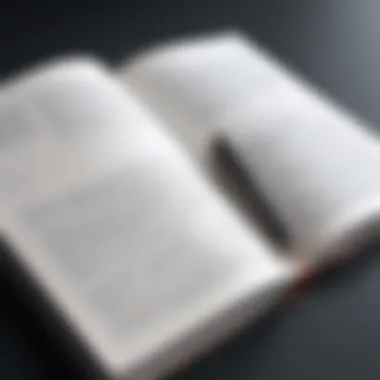Mastering the Art of Reading a Book in a Day Efficiently


Intro
Reading a book in a single day is a fascinating goal for many. While some view it simply as a fun challenge, others recognize the potential benefits tied to enhancing comprehension and retention through intensive reading sessions. In a world inundated with information, possessing the ability to consume and process content quickly is invaluable. This article serves as a meticulous guide, addressing the methods, strategies, and considerations necessary to commit oneself to this feat.
Understanding your unique reading style and adapting techniques to that will promote success. There are variables that influence a reader’s pace, ranging from concentration levels to prior knowledge about the subject matter. Therefore, mastering this process requires a blend of curiosity, effective time management, and planned reading habits.
Prolusion
Reading a book in a single day seems like an ambitious feat. However, understanding both the mechanics of reading and the specific strategies to employ makes it an achievable goal. Formulating a productive approach towards this challenge can offer significant personal growth.
In today’s world, where information overload is prevalent, devoting time to reading can enhance one’s cognitive capabilities. Reading aids in improving concentration and critical thinking. Every book read can expand knowledge, hence contributing toward a well-rounded intellectual profile. It becomes vital to appreciate the intersection of effort, time commitment, and the rewards transcending beyond mere enjoyment of a story.
Understanding the Challenge
The concept of reading a book in a day requires more than briskly flipping pages. It involves recognizing variables that impact reading speed, such as individual reading proficiency, book structure, text density, and ultimately, the reader's end goal. Furthermore, comprehension retains prominence, ensuring that skimming through content doesn't lead to losing pivotal insights or knowledge.
Setting realistic expectations is crucial. Readers must evaluate what ‘completing a book’ means for them. This can mean absorbing long narratives fully or just extracting key messages from technical texts. Tackling longer or denser books might necessitate different techniques, calling for a strategic adjustment. Addressing different genres also plays a significant role. Ultimately, balancing speed and understanding defines the challenge but creates beneficial growth through this learning process.
Purpose of the Article
This article seeks to elucidate how one can efficiently read a book in a day without compromising retention or depth of understanding. By dissecting varying aspects of reading such as planning, techniques, and environment, readers can formulate a practical strategy tailored for them. This exploration serves readers who have a desire to improve not only their reading speed but also their overall approach towards acquiring information from texts.
Moreover, shedding light on this process fosters the appreciation of books themselves in a time when instant information is laced with superficiality. Through mastery of reading in a single day, individuals can foster a meaningful connection to literature, something revitalizing in our fast-paced world.
Defining Reading a Book in a Day
Reading a book in a day is an alluring concept. It presents an efficient way to consume knowledge quickly. The importance of this practice lies in understanding themes, insights, and viewpoints rapidly. This section will unpack the nuances of this goal, focusing on reading speed and types of books that facilitate the objective.
Reading Speed
Reading speed is a crucial element when defining the feasibility of completing a book in a day. Average reading speed varies by individual and text complexity. Generally, it falls between 200 to 300 words per minute (wpm) for most adults. Optimizing one’s reading speed can involve practice and techniques.
- Skimming allows assessment of main ideas whilst bypassing details.
- Scanning requires seeking specific information quickly while minimizing reading time.
- Expanded eye-tracking can also help in noticing patterns without focusing on each word.
Attention to context matters as well. Complex texts require slower reading, while easy narratives may allow for faster progress. Knowing your own pace helps in planning an achievable reading goal.
Types of Books
Different types of books lend themselves to single-day consumption more readily than others. Setting the right book aligns well with both the reader's interests and cognitive engagement.
- Fiction: Novels and stories often grab attention with compelling narratives and character development. Works such as "The Alchemist" by Paulo Coelho invite reader immersion.
- Non-fiction: Self-help or motivational books like "Atomic Habits" by James Clear provide concise strategies, making them easier to navigate.
- Shorter works: Essays or novellas often contain rich ideas condensed into fewer pages. Those like "Animal Farm" by George Orwell illustrate impactful simplicity.
In essence, focusing on book type influences reading speed and the overall experience. Choosing a stimulating andare properly manageable text is as significant as the act of reading it itself.
Planning Your Reading Day
Planning is a vital component when attempting to read a book in one day. It structures your approach and helps to divide a significant task into manageable segments. Careful planning involves selecting the right book, creating a schedule and establishing a conducive environment. Understanding these elements can significantly elevate your reading experience.
Selecting a Book
Choosing the right book plays a pivotal role in achieving your reading goal. The selection should resonate with your interests or current knowledge gaps. Additionally, the complexity and length of the book are important factors. More digestible texts can facilitate easier understanding and retention. Genres like personal development or short stories can be a great option. Alternatively, more complex works, such as dense novels, could lead you to become overwhelmed and burnt out. Ensuring the subject matter aligns with your interests will motivate you through the day. Look also for books of a suitable length that can hold your attention without dragging.
Creating a Schedule


Establishing a clear schedule is fundamental. Divide your reading time into focused blocks. For example, a common approach would be allocating one to two hours for each chapter or section of your book. Set concrete start and end times for each block and moderately factor in breaks. Frequent short pauses can refresh your mind, allowing for greater concentration.
Explore tools like Google Calendar or Trello to manage your timetable effectively. These tools can assist with reminders and visual indicators of your progress. The importance of sticking to your plan should not be underestimated; a structured reading day can prevent procrastination and enrich comprehension.
Setting Up Your Environment
An ideal reading environment can greatly influence how effectively you read. Select a space that’s quiet, well-lit, and free from distractions. Limit access to your phone or other devices that might interrupt. Creating a comfortable atmosphere can enhance focus and concentration. Consider using noise-canceling headphones or soft music to minimize background interruptions. There’s an element of personal preference here; enough trial can help identify what precisely works best for you.
A well-set environment maximizes your chances of successfully reading a book in a day.
Techniques for Efficient Reading
To successfully read a book in a single day, one must focus on effective reading techniques. These methods enhance understanding while encouraging a more engaging experience with the text. Each technique plays a vital role in dealing with lengthy material and ensuring meaningful retention of information.
Skimming and Scanning
Skimming and scanning are invaluable skills for quickly gathering information and understanding core concepts.
- Skimming involves reading rapidly to capture the main ideas. It’s useful when time is limited and you want an overview of the book's framework. This process includes focusing on headings, subheadings, and any highlighted text like quotes or key ideas. Knowing how a book's structure aligns with its content can yield insights even without deep engagement.
- Scanning is different. It entails searching for specific information. For instance, if you wanted to find a topic discussed within a chapter, you'd move your eyes quickly over the text rather than absorbing it completely. Both skills are essential for achieving a comprehensive summation of a book quickly.
Incorporating both techniques will allow you to read more effectively against the ticking clock of a reading day.
Note-Taking Strategies
Note-taking anchors your thoughts during your reading hours. It builds connections between ideas, facilitating better retention of what you've read. Below are some strategic approaches for effective note-taking:
- Cornell Method: Divide your page into questions, notes, and summary. This format helps in organizing thoughts and encourages engaging with content actively.
- Mind Mapping: Use diagrams to connect ideas visually. This helps you capture relationships between concepts effectively.
- Bullet Points: Employ lists for quick, digestible notes. This is particularly handy when documenting key aspects without losing the context.
Your notes should not be excessive but rather concise and clear. This practice emphasizes and strengthens the core ideas of the book, making revisits much easier.
Active Reading Methods
Active reading transforms the engagement level with the text. It encourages thinking alongside the words. Here are some effective active reading methods:
- Questioning: Prepare questions regarding what you predict the chapter might cover before diving in. This primes your mind for more focused reading.
- Annotation: Highlighting and making notes in the margins clarifies your thoughts and promotes an interactive reading session. It’s beneficial as quotes or passages resonate with your thinking.
- Reflection: After each section, pause to reflect on what you just read. This solidifies understanding and can raise flags for anything that may need further review.
Engaging in these methods breeds contemplation and deepens your grasp of the material.
These techniques collectively build a systematic approach to tackling the challenge of reading a book in a single day, enhancing your skills and aiding retention. By mixing and matching these strategies, you can tailor them to fit the book's complexity and length, leading to more enjoyable and fruitful reading sessions.
Gaining Comprehension and Retention
In the journey of reading a book in a day, comprehension and retention hold paramount importance. While speed is often emphasized, understanding the material is what ultimately enriches the experience. The goal is more than just reading the words; it is about connecting ideas and internalizing learning. Without solid comprehension, the purpose of reading suffers.
Retention refers to the ability to remember and apply the information acquired from reading. This skill ensures that the knowledge gained does not fade away after a quick glance at the text. Focusing on comprehension aids retention, allowing for better integration of new information into existing frameworks. Efficient readers not only savor the content but also store it for future reference, making it readily available for application in various contexts.
Key Elements for Gaining Comprehension:
- Active engagement with the text.
- Identifying main ideas and structure.
- Relating concepts to prior knowledge.
Understanding this significance sets a positive tone throughout the reading day. Establishing the connection between what is read and its meaning enhances the quality of the reading experience.
Understanding Key Concepts


Finding key concepts in a book is vital to efficient reading. These concepts generally anchor all other supporting information within the text. Identifying points like thesis statements or main arguments ensures that readers grasp what the book is about. A strategic approach helps clarify critical content that deserves more focus.
Be mindful of these methods for identifying key concepts:
- Look at headings and subheadings to frame understanding.
- Pay attention to bolded or italicized text which signal significance.
- Ask questions before reviewing each chapter to enhance insight.
These strategies support a seamless flow of comprehension.
Summarizing Information
After digesting the main ideas, summarizing information consolidates understanding. A summary distills core points into concise statements, converting complex information into manageable chunks.
To effectively summarize:
- Shorten paragraphs into one-liners reflecting their main ideas.
- Use bullet points for clarity, encapsulating themes.
- Avoid including personal interpretations in this phase, sticking closely to the book's text.
Creating a well-formed summary counters information overload while reinforcing retention. This technique aids breaking down intricate themes, leading to a clearer overall picture.
Reviewing Material
Regular reviews of the material ensures that retention stays intact. Dedicate short periods to revisit notes or summaries after reading commitments. This habitual engagement cements information permanently, enabling applications in conversations or personal reflections.
Consider these suggestions for effective reviews:
- Schedule brief reviews after major sessions to ensure continuity.
- Discuss points with others; verbalizing enhances memory.
- Use tools like mind maps or flashcards for visual recall.
Implementing reviews fosters a system of interconnected knowledge, contributing to a profound understanding that would enrich the overall reading experience.
"Reading without reflection is like eating without digesting." - Edmund Burke
By focusing on comprehension and retention, you build a meaningful foundation for every book you tackle in a day. Paying attention to these elements allows readers to engage deeply, turning what could be an exhaustive task into an enriching, memorable journey.
Potential Benefits of Reading a Book in a Day
Reading a book in a single day offers a range of distinct benefits, some of which are often overlooked. In this fast-paced world, taking time out to focus intently on a book can improve not just one’s reading skills, but also various cognitive faculties. Engaging deeply with literature is important, especially as it contributes significantly to intellectual growth.
"Reading is to the mind what exercise is to the body, a path to a stronger, clearer self."
Enhancing Focus
One significant advantage of reading a book in a day lies in enhanced focus. The methodical approach of dedicating an entire day to immerse oneself in text fosters an environment where distraction is minimized. This solitary time allows one to develop concentrated attention, which is increasingly scarce in today’s distracted existence.
Greater focus when reading helps in not only comprehending the material better but also in engaging with the content at a deeper level. Deep work, as some may call it, nurtures mental clarity and discipline, potentially enhancing productivity in other areas of life, especially for tech-savvy individuals who operate in environments with constant interruptions.
Expanding Knowledge
Reading a book thoroughly can lead to substantial knowledge acquisition. Books often contain a myriad of insights encapsulated in a compact form. When read in one session, the transformation of information becomes immediate and holistic.
This practice encourages exposure to new perspectives and ideas, broadening one’s intellectual horizons. For early adopters of technology, staying informed an literature often reflects the pace of current events and trends. Understanding them leads to better-informed discussions and decisions, especially in fields where technological innovations emerge rapidly.
Cultivating a Reading Habit
Incorporating the endeavor of reading a book in a day into one’s routine might establish a consistent reading habit. Consistency tends to be the mother of mastery. Dedication to reading ensures regular interaction with literature, leading to not just improved speed and comprehension, but also the discovery of personal preferences regarding genre and style. Developing a studious regime around reading lays the groundwork for long-term intellectual engagement. This practice proves beneficial for anyone seeking to enhance their reading skills, as regular scrolling through texts can translate to enhanced abilities in deciphering complex materials in professional contexts.
Addressing Common Misconceptions
Addressing misconceptions surrounding reading a book in a day is crucial. Many people believe that fast reading leads to poor comprehension. This belief can discourage those who wish to explore reading as a focused and rewarding activity. Misconceptions also extend to the types of books suitable for this challenge. Some suggest certain genres are more appropriate than others, but this statement is too broad. Understanding these issues enables readers to approach the day with realistic expectations and prepared strategies.


Quality of Reading
Engaging in a single-day read can challenge traditional beliefs about the quality of reading. Usually, we infer that to understand a book thoroughly, one must take their time with it. However, the real measure of reading quality lies in how one interacts with the text.
While speed may seem detrimental at a glance, focused reading can yield insights. The ability to concentrate intensely on the material allows readers to grasp key themes and arguments. It's not merely about ingesting information; it is also about filtering and synthesizing that knowledge. Additionally, many find that reading one book after another can enhance their appreciation of different writing styles and deeper understanding of themes. The experience can be equally enriching as leisurely reading. In fact, dedicating a day to one book may foster more profound engagement than scattered reading over weeks.
Retention vs.
Speed
The ongoing debate accentuates that speed and retention are not mutually exclusive, contrary to popular belief. Critics argue that speeding through a book compromises memory. Although speed reading challenges how most readers engage material, it creates an opportunity for honing specific cognitive skills.
Through techniques like skimming and wide-scope reading, one can become adept at determining what is essential for retention. Maintaining a pace that allows comprehension helps solidify memory pathways by focusing on high-quality, relevant pieces of information.
It’s essential to apply perceptive practices here. For instance, quoting critical ideas or drawing connections between different sections can significantly aid the retention of information. Thus, while one's reading speed might naturally fluctuate, retaining knowledge is feasible when employing the correct methods.
“Efficient reading is less about speed alone and more about the adeptness in managing comprehension and retention.”
Ultimately, discerning the standpoint in this conversation allows readers to remain better informed. Quality reading encompasses varied dimensions rather than merely the number of pages turned in a day.
Practical Examples
Practical examples serve as valuable tools to comprehend the intricacies of reading a book in a day. They provide real-world scenarios and actionable insights that help readers understand how various strategies can be applied. The importance of this section lies in its ability to illustrate the effectiveness of methodologies described in earlier sections. With specific case studies and recommendations, readers can visualise their journey toward mastering this skill.
Case Studies
Exploring case studies is a practical way to see how individuals from diverse backgrounds have succeeded in reading a book within a day. For instance, one woman shared her experience where she took a day off work to finish a biography she had put off for months. Through effective pacing and timed breaks, she managed to grasp the key themes and reflect on the author's insights, which enhanced her comprehension.
Another example involves a college student preparing for an exam. She selected a textbook dense with concepts relevant to her coursework. Using skimming and scanning techniques established earlier in the article, she extracted essential ideas swiftly, ultimately applying her knowledge in the exam. These case studies not only highlight different contexts but also emphasize the varied approaches to achieving the same goal of completing a book in a single day.
Reference Books Recommended
Reading recommendations can significantly impact the success of reading a book in a day. Choosing concise yet informative titles ensures that the task remains feasible, setting individuals up for success. Below, several highly regarded books have been curated for readers, touching upon diverse genres:
- **
Culmination
Reading a book in a day is not merely a test of one’s cognitive speed but a nuanced exploration of managing time, understanding content, and retaining information. The journey to achieve this may involve techniques that enhance comprehension and focus. Through this article, we have unpacked the vital components needed for successful one-day reading. Specifically, understanding your reading speed and selecting the right types of books can help set realistic goals.
When discussing strategies, we explored various methods like skimming and scanning, which serve as critical tools for tackling dense material quickly. These techniques not only ensure that readers can extract key information rapidly but also foster an engagement with the text that can elevate the reading experience. Furthermore, employing active reading alongside effective note-taking strategies enhances retention, enabling readers to absorb and utilize information more practically.
Addressing misconceptions is crucial, especially the prevalent belief that speed undermines quality. This article argues against that sentiment by empathizing that comprehension lies at the heart of a fulfilling reading experience. In shifting focus toward methods that combine speed with understanding, we can demystify what it means to have both.
Recap of Strategies
To summarize, the some key strategies identified throughout the article focus on:
- Selecting the right material that aligns to your reading level and interest.
- Establishing a structured schedule within your day to manage reading times effectively.
- Utilizing skimming and scanning techniques to gather main ideas quickly.
- Incorporating active reading by writing notes, highlighting, or asking questions while you read.
- Taking the time afrter each reading session to review or summarize key concepts to reinforce retention.
Each of these approaches not only contribute to reading a book within a set timeframe but also enhance the overall understanding, establishing a beneficial habit long-term.
Encouragement for Future Reading Goals
As you set out on future reading challenges, remember to remain flexible in your approach. Whether it is the continuing practice of reading books in a day, or simply upping your daily reading volume, focus on your own pace and preferences. Experimentation with different techniques will refine your method over time, aligning with your goals.
Setting realistic objectives is likewise fundamental. Instead of depending on speed alone, think about how reading fits woven into your everyday life. Define what you hope to gain from reading. This knowledge of your own motivations can secure that reading remains an enriching pursuit color for you.
Achieving mastery in reading, despite pressures, is ultimately about celebrating small successes along the way.
Focus enhances comprehension and retention, while a sustainable reading practice steadily elevates knowledge and skills. Invest in your journey, encourage balance, and guard the purpose behind your reading efforts.







